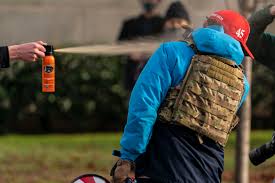When it comes to personal safety, two commonly used self-defense products are bear spray and pepper spray.
While they may seem similar, there are important differences that should be understood before choosing the right one for your needs.
In this article, we will explore the variations between bear spray and pepper spray, including their composition, effectiveness, range, legal considerations, safety precautions, and more.
Differences in Composition
Bear spray and pepper spray differ in their active ingredients. Bear spray contains a deterrent specifically designed to repel bears, usually using capsaicin and related capsaicinoids as the primary agents.
On the other hand, pepper spray, often used for personal defense against humans, typically contains oleoresin capsicum (OC) as its active ingredient. The concentration and capsaicin levels also vary, with bear spray generally having a higher concentration to effectively deter bears.
Targeted Users
Bear spray is primarily intended for protection against aggressive bears in outdoor settings. It is commonly used by hikers, campers, and wildlife enthusiasts who may encounter bears in their natural habitat.
Pepper spray, on the other hand, is designed for personal defense against human attackers. It is popular among individuals concerned about their safety in urban environments or while engaging in activities like jogging or walking alone at night.
related: Pepper Spray Vs Gel: Which Is Ideal?
Effectiveness
Bear spray is highly effective against bears due to its specialized formula. The high concentration of capsaicinoids in bear spray creates a strong deterrent, causing temporary discomfort and pain to bears, deterring them from approaching further. Pepper spray is also effective but is formulated to incapacitate humans. It causes severe irritation to the eyes, skin, and respiratory system, allowing victims to escape or seek help while the attacker is immobilized.
Range and Spray Pattern
Bear spray is designed to have a wide spray pattern, covering a larger area to create a barrier between the user and the bear. It typically has a range of around 20 to 30 feet, providing a buffer zone for the user. On the other hand, pepper spray usually has a narrower stream or cone pattern, allowing for more accurate targeting of human attackers. The range of pepper spray varies but is generally around 10 to 15 feet.
Legal Considerations
The legality of bear spray and pepper spray can vary depending on the jurisdiction. Bear spray is often regulated as a wildlife deterrent and is legal in most areas where bears are prevalent. However, it is essential to check local regulations before carrying or using bear spray. Pepper spray, on the other hand, is more widely available and legal in many regions for personal self-defense. Nonetheless, it is crucial to be aware of any restrictions or requirements imposed by local laws.
Safety Precautions
When using bear spray, it is important to follow specific safety precautions. Users should familiarize themselves with the instructions provided by the manufacturer, practice proper handling techniques, and understand the limitations of bear spray. Pepper spray users should also exercise caution and adhere to safety guidelines. This includes being aware of wind direction, maintaining a safe distance from the attacker, and practicing using the spray beforehand to ensure familiarity with its operation.
Storage and Shelf Life
Proper storage of bear spray and pepper spray is vital to maintain their effectiveness. Bear spray should be stored at room temperature and should not be exposed to extreme heat or cold, as this can affect its performance. It is essential to check the expiration date and replace the canister if it has reached its shelf life. Pepper spray should also be stored in a cool, dry place and regularly inspected for any signs of damage or expiration.
Conclusion
In conclusion, bear spray and pepper spray are distinct self-defense products with different purposes. Bear spray is formulated to repel bears and is commonly used in outdoor settings, while pepper spray is designed for personal defense against human attackers. Both sprays have unique compositions, effectiveness, ranges, and legal considerations. It is crucial to choose the appropriate spray based on your specific needs and to follow safety guidelines for their proper use. Remember, proper knowledge and preparedness can significantly contribute to personal safety in potentially dangerous situations.
FAQs (Frequently Asked Questions)
Q1: Can I use bear spray as a substitute for pepper spray?
No, bear spray should not be used as a substitute for pepper spray. Bear spray is specifically formulated to deter bears and may not be as effective against human attackers. Pepper spray, designed for personal defense, is a more suitable option in situations where protection against humans is required.
Q2: Is bear spray legal everywhere?
Bear spray is legal in most areas where bears are prevalent, but regulations can vary. It is essential to check local laws and regulations regarding the use and possession of bear spray before carrying or using it.
Q3: Can pepper spray be used against bears?
While pepper spray may temporarily deter a bear, it is not as effective as bear spray specifically formulated for repelling bears. It is recommended to use bear spray when encountering bears in outdoor settings for optimal safety.
Q4: How long does the effect of bear spray last?
The effects of bear spray typically last for about 30 to 60 minutes, providing a window of opportunity for users to retreat to safety. However, the exact duration can vary depending on factors such as wind conditions and the individual bear’s reaction.
Q5: Can I purchase bear spray without any restrictions?
The purchase of bear spray may be subject to certain restrictions, depending on the jurisdiction. It is essential to familiarize yourself with local laws and regulations before purchasing bear spray to ensure compliance and responsible usage.
Bliss Ferdinand is a resilient single mother and the founder of pepperspraymum.com, a blog dedicated to empowering women and promoting personal safety. With a passion for self-defense, Bliss shares her knowledge and experiences to help other mothers protect themselves and their families. Through her blog, she educates her readers about the effective use of pepper sprays, offering valuable insights, product reviews, and practical tips on staying safe in various situations. Bliss’s commitment to her community has inspired many women to take charge of their own security, making pepperspraymum.com a go-to resource for those seeking practical advice and peace of mind


